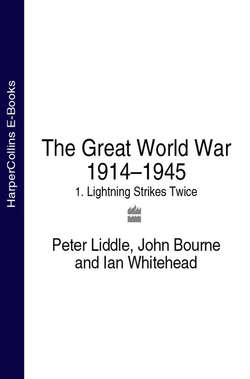Читать книгу The Great World War 1914–1945: 1. Lightning Strikes Twice - John Bourne - Страница 6
ОглавлениеA part from debates about the international ramifications of the Treaty of Versailles, historians have tended to study the two world wars in isolation. This has been justified by the assumption that the two conflicts were qualitatively and quantitatively different. The First World War has more often than not been regarded as a ‘bad’ war resulting from failures in diplomacy, and a war characterised by the ‘futile’ sacrifices of trench warfare on the Western Front; standing in stark contrast to the justifiable and necessary struggle, between 1939 and 1945, against Nazi tyranny and aggressive Japanese militarism. In the First World War the civilian populations of the belligerent powers played an increasingly vital part in the war effort. But it is the Second World War, with its indiscriminate bombing of cities placing civilians in the front line, and technology taking man’s destructive powers to new heights, that is more usually seen as the first truly ‘total’ war. To treat the wars separately in this fashion, however, is to ignore a significant historical reality – all those who were over forty years of age in 1940 would have had their adult lives in some sense defined by their participation, or non-participation, in these two global conflicts. It is this continuum of human experience that firmly unites the world wars, and which is the focus both of this book and its successor volume.
The aim throughout is to demonstrate the diversity of personal experience in the two world wars. This volume examines uniformed service and such aspects of civilian experience as occupation, displacement and genocide. It discusses the exercise of political and military leadership and details the difficulties of prosecuting coalition warfare. The later volume deals with the national experiences of both belligerent and neutral states and considers the role of civilians in war. There are also sections dealing with moral and cultural issues.
The comparative approach that underpins the book reveals striking parallels between the two global conflicts of the twentieth century. It is clear that in many respects lightning did indeed strike twice – when considering the development of modern warfare, its challenges and its impact, there is much that unites the two conflicts. Indeed, it is tempting to conclude that, in relation to human experience, there was nothing fundamentally new in the Second World War. There were, however, important differences, none more significant than the ideological basis of the struggle between Nazi Germany and her opponents. The First World War was, in part at least, the product of ancient Balkan savageries and the fate of the Armenians gave warning of the human capacity for organised atrocity on the scale of genocide, a word not yet then coined. But a new register is required to measure the consequences of ideological warfare in the Second World War. German and Japanese conduct of the Second World War was driven by racism and political dogma. This and the response it provoked from the Soviets on the Eastern Front, the Americans in the Pacific and the British and Americans in the skies above Germany and occupied Europe ensured that the Second World War extended the frontiers of human degradation and misery well beyond the boundaries ‘achieved’ in the earlier struggle.
